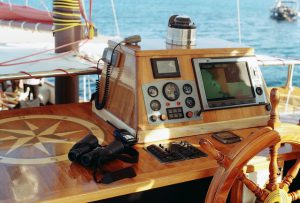A few years ago, a friend of mine backed out of the dock only to learn that his steering linkage had broken, and he no longer had control over the vessel… what now?
And just a few weeks ago my friend Mark shared with me via email “I did the normal pre-departure checks prior to sailing Thursday & Friday and found no problems. Then on Saturday, I found the bilge below the motor full of water when I looked into the engine compartment prior to leaving the slip. I found this to be saltwater, so I shut the raw water sea cock and searched for the leak. It turned out to be at the impeller housing, or at the end of the hose that connects to the impeller housing. It is under the alternator and super hard to access so I can’t tell for sure where the water is coming from, but there was a stream of water shooting out that slowly filled the bilge below the motor with sea water over the course of a day or so. I borrowed a hand pump from a guy a few slips down to remove the water so the engine wasn’t sitting in salt water.
As I mentioned, there were no problems found during my checks before sailing Thursday or Friday, but there was on Saturday.”
This means it’s really important to do all the pre-departure checks every day before you shove off.
![]()
Look, you can’t prevent every issue, but these things happen and wouldn’t you rather find out before you untie if possible? Every vessel is different so every one will have its own version of the list. Here are a couple that I recommend that I don’t think a lot of private skippers do. And I suggest you do these every time:
- When you start your engine, check over the side of your vessel to make sure the engine is expelling water. Water is what cools your engine, and if water is not coming through for some reason, the time to find out is now.
- Then, just before you untie, put your vessel in gear; forward for 30 seconds and then reverse for 30 seconds. In forward gear, look over the stern of your vessel and you should see the water a little disturbed. When in reverse gear, look over the side.
- Finally, turn your rudder all the way left and all the way right. If you have an autopilot, it probably has an instrument in it that tells you where your rudder is in relation to center. Watch that dial as you turn the wheel. If everything looks good and feels normal, then you can shove off (if the linkage is broken, the wheel will spin too easily).
Fortunately for my friend who lost steering, there were a few boaters on the docks willing to help out. He threw them some lines and they wrangled the boat back into the slip. But an extra 2 minutes spent running a couple of prelaunch checks would have been an even better solution.

If you need a pre-departure checklist, drop me a line and I’ll send you mine… it will likely need some adjusting based on how your vessel is different than mine, but it will help you get started, and I assure you there are way more than these 3 items on it.
Fair Winds
Captain Jeff Vegas
 Terms of Use
Terms of Use
[…] the day’s voyage because you always do that (you do always do that, right… during your pre-departure checks?). You slide the small latches to the unlocked position, and there is a little swinging door, sort […]